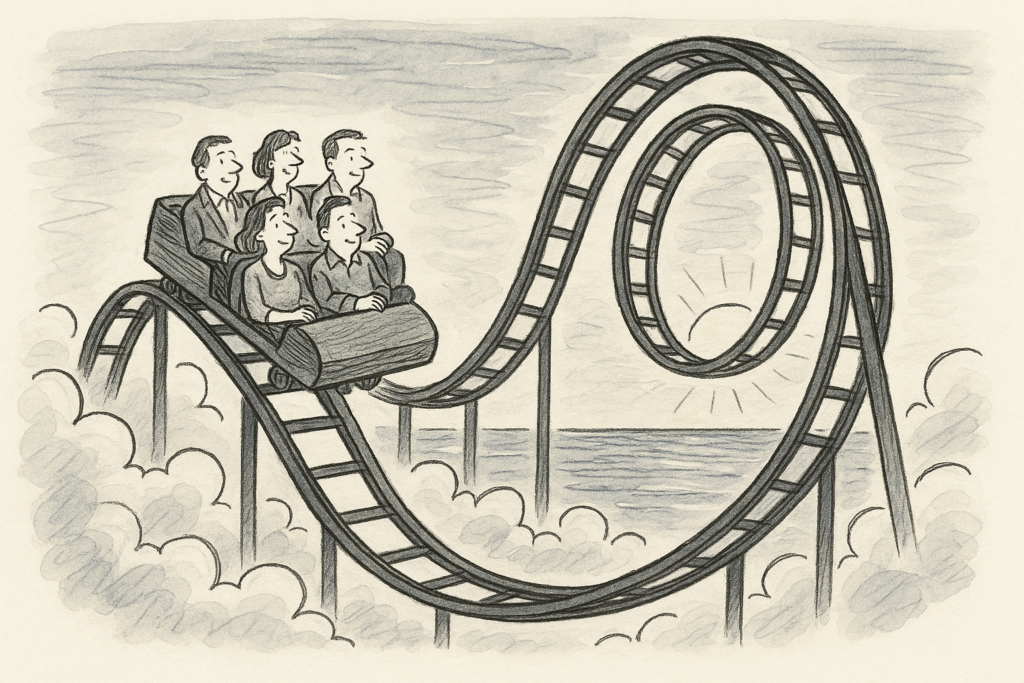A Timely Reminder to Keep Going
 Market volatility is back in the headlines, and if you’re feeling uneasy, you’re not alone. Over the past month, markets have given us another sharp reminder of what it means to be an investor. On April 2nd and 3rd, the S&P 500 fell a combined 10.7%—a drop that understandably triggered anxiety for some. And just when the idea of sitting on the sidelines might have felt tempting, the market turned on a dime. On April 9th, the S&P 500 gained 10.5% in a single day, quickly recapturing much of the prior decline.
Market volatility is back in the headlines, and if you’re feeling uneasy, you’re not alone. Over the past month, markets have given us another sharp reminder of what it means to be an investor. On April 2nd and 3rd, the S&P 500 fell a combined 10.7%—a drop that understandably triggered anxiety for some. And just when the idea of sitting on the sidelines might have felt tempting, the market turned on a dime. On April 9th, the S&P 500 gained 10.5% in a single day, quickly recapturing much of the prior decline.
That’s the market. It moves. Sometimes violently. In hourly bursts. Often unpredictably. And always in response to new information.
One of the best examples of this came on April 9th at 1:18 p.m. Eastern, when President Trump posted on Truth Social that he would lift tariffs on all countries other than China. Within ten minutes of that post, the S&P 500 had surged nearly 6%. Markets are incredibly efficient at digesting new information, whether it’s about trade policy, inflation, interest rates, or elections. The current price of a security reflects the consensus expectations of millions of participants, each with skin in the game.
So what should you do in the face of this kind of uncertainty?
Stick with your plan.
At Hill Investment Group, every client portfolio is built around a long-term strategy, not short-term noise. Your plan was designed with the understanding that markets will experience sharp moves, both up and down. We don’t pretend to know what tomorrow’s headlines will be or how the market will respond to them. What we do know—based on decades of data and mountains of research—is that markets are priced to deliver a positive expected return every single day. That’s why being in the market is so critical.
Missing just a handful of the best days has an outsized impact on long-term results. And as we just saw, those days often come immediately after the worst ones. Getting out and waiting “until the dust settles” may feel comforting, but it’s rarely profitable.
Global diversification is also part of the plan.
This year offers a good reminder of why. While the S&P 500 is down 9.7% year-to-date as of April 22nd, international developed and emerging markets are actually up 6.3%. No one can consistently predict which areas of the market will outperform in the short term. That’s why we build portfolios that don’t rely on a single country or asset class to deliver returns. Diversification ensures that when one area of the market struggles, others may pick up the slack. It’s not just about reducing risk—it’s about improving the odds of long-term success.
Instead of reacting to volatility, we encourage our clients to focus on what can be controlled—things that actually add value:
- Tax Loss Harvesting – When markets decline, we actively harvest losses to offset gains elsewhere in your portfolio. This reduces your tax bill while keeping you invested.
- Rebalancing – We monitor portfolios to ensure your exposure to risk remains aligned with your plan, buying when assets are down and trimming when they’ve run up.
- Staying the Course – Most importantly, we help you stay focused on the big picture. Financial goals aren’t achieved in a week or a month—they’re met over years and decades by maintaining discipline and a long-term perspective.
Trying to respond to every market move or every tweet is not an investment strategy. It’s gambling. It’s a recipe for regret.
So yes, volatility has returned. And no, we can’t predict what comes next. But we can control how we respond. And our response is grounded in evidence, backed by decades of research, and aligned with your goals.
We’re here to help you take the long view. That’s not just a tagline—it’s a philosophy that has helped our clients build and preserve wealth through all kinds of markets. And it’s one we continue to believe in today.
Stick with it.
Hill Investment Group is a registered investment adviser. Registration of an Investment Advisor does not imply any level of skill or training. This information is educational and does not intend to make an offer for the sale of any specific securities, investments, or strategies. Investments involve risk, and past performance is not indicative of future performance.


